#l sprague decamp
Explore tagged Tumblr posts
Text
Regarding L. Sprague deCamp's biography of H. P. Lovecraft that was published in 1975: deCamp really goes hard on Lovecraft's bigotry, racism, and general white supremacy prattle. I will say that nothing can excuse Lovecraft's politically incorrect pronouncements, but deCamp really seemed to harp on it excessively. deCamp's bio almost comes off as a ultra-liberal father's warning to his children, "Don't be like this Lovecraft guy, kids! He was a lousy self- promoter, a wimpy momma's boy, and a delusional anti-commercialist who fantasized that he was some sort of "Artist". As I've mentioned before in these posts, deCamp's LOVECRAFT A BIOGRAPHY came out in hardback the same year as the FIRST WORLD FANTASY AWARDS. This landmark convention was held in Providence, RI. in October of 1975. Of all the fans of Lovecraft's fiction who were in attendance I am almost certain that NONE of them were fascists, racists, neo-Nazis, or secretly members of the Klan. I don't know anyone who ever read Lovecraft's stories or essays who was inspired by his ideas to become a racist. One has to ask, "What audience was deCamp going for with his 'hit-piece' biography?" Did he actually believe the population at large would ever give a Damn about someone like H. P. Lovecraft? Certainly those of us who were already part of the underground H. P. Lovecraft fan movement that began running hot in the early 70s already knew HPL had outdated and deplorable racial views. We'd all read THE RATS IN THE WALLS and knew what the protagonist had named his pet black cat. Now it's true that one or two of the surviving members of the original 'Lovecraft Circle' had defended deCamp's presentation of Lovecraft, but most did not. For those of us who admired Lovecraft despite his negatives, deCamp's bio was an insult not only to Lovecraft but to us as well! (Exhibit 589)

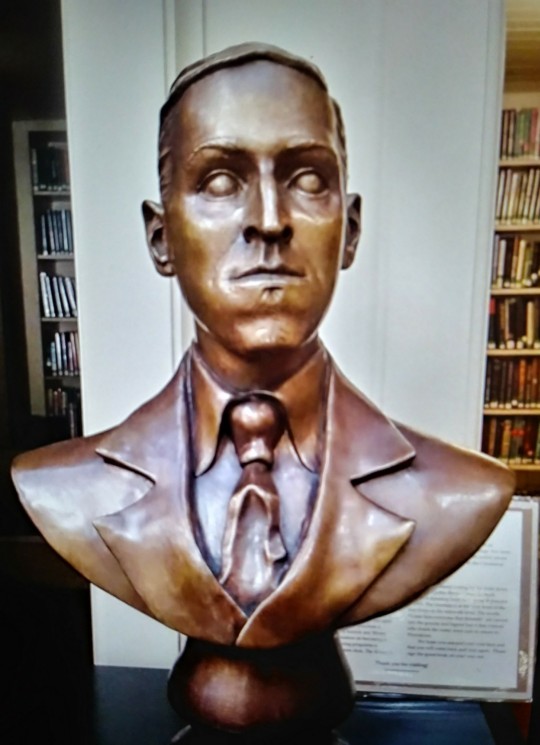


3 notes
·
View notes
Text
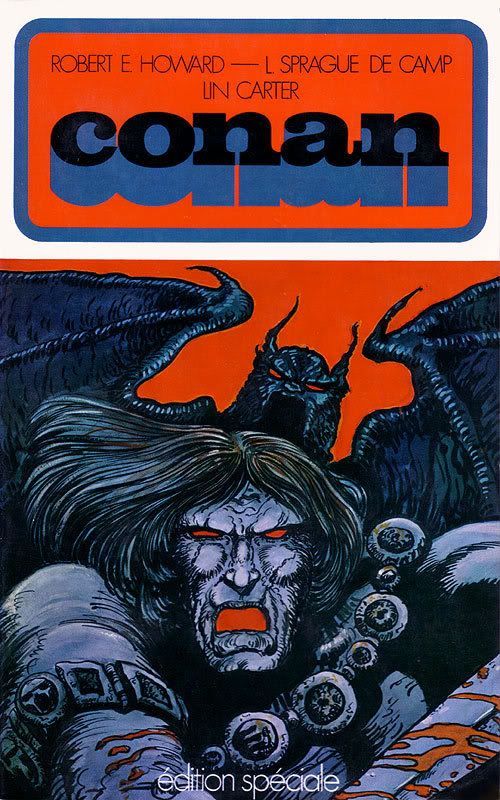
cover for french Conan (1972, yes still the Lin Carter L Sprague DeCamp era of"edited " Robert E Howard) by Phillippe Druillet
75 notes
·
View notes
Text
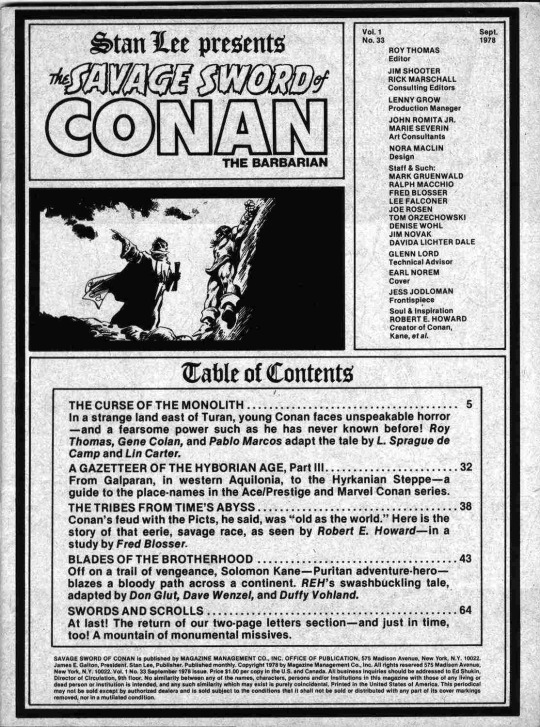




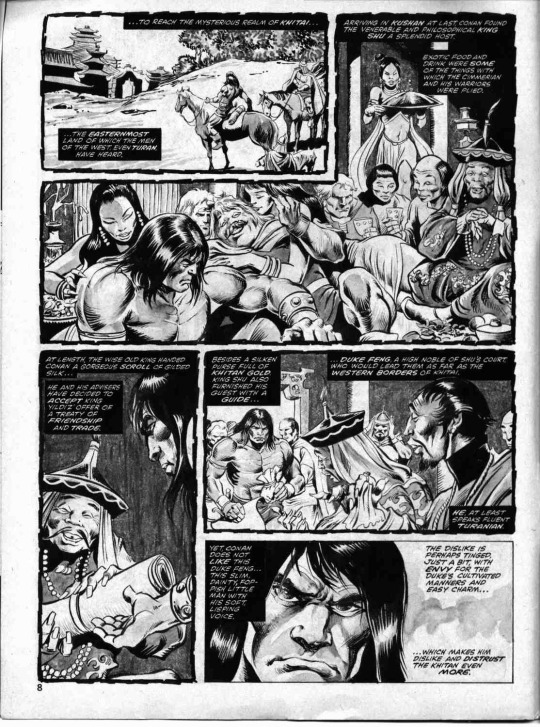
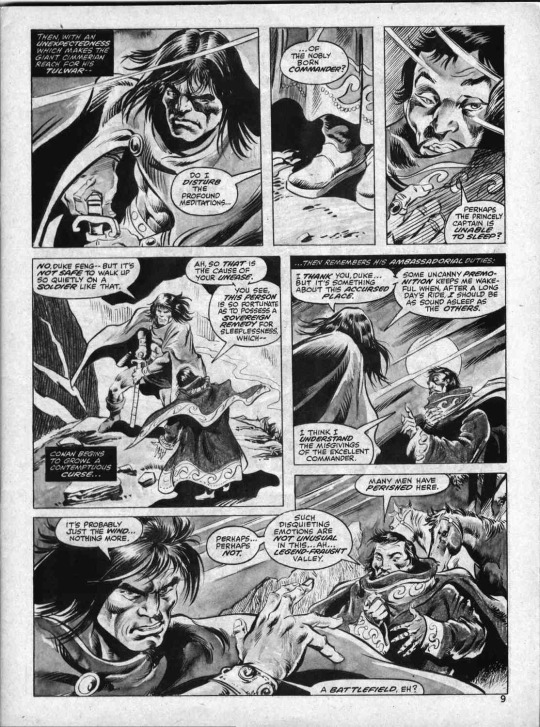



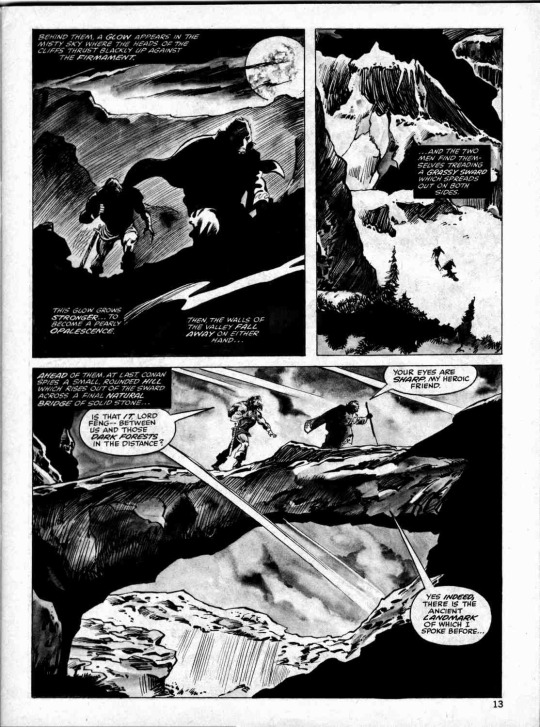

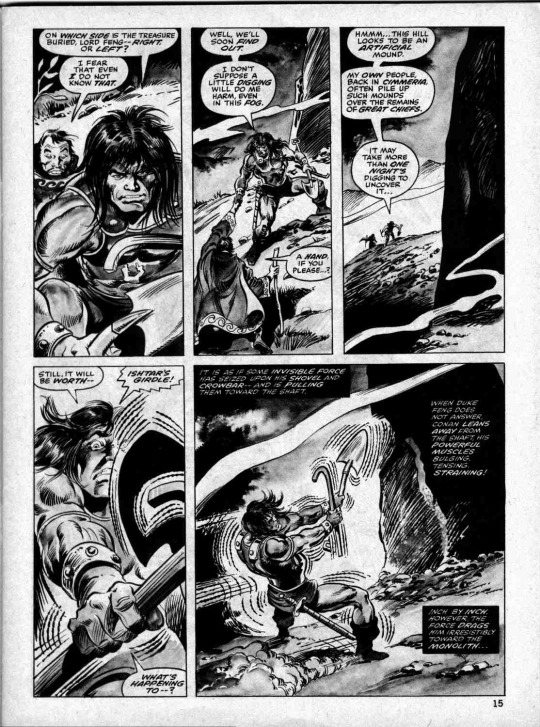
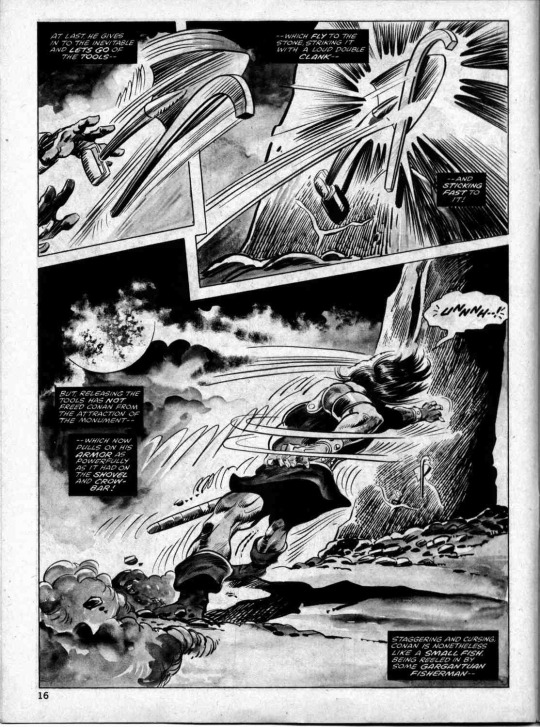

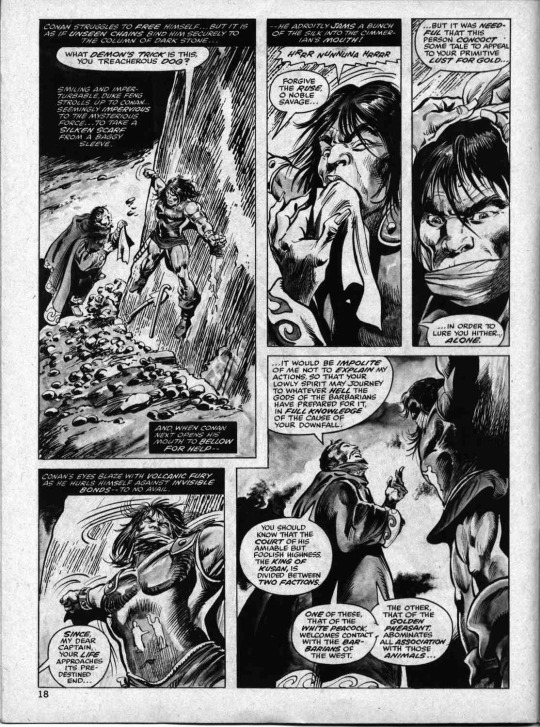

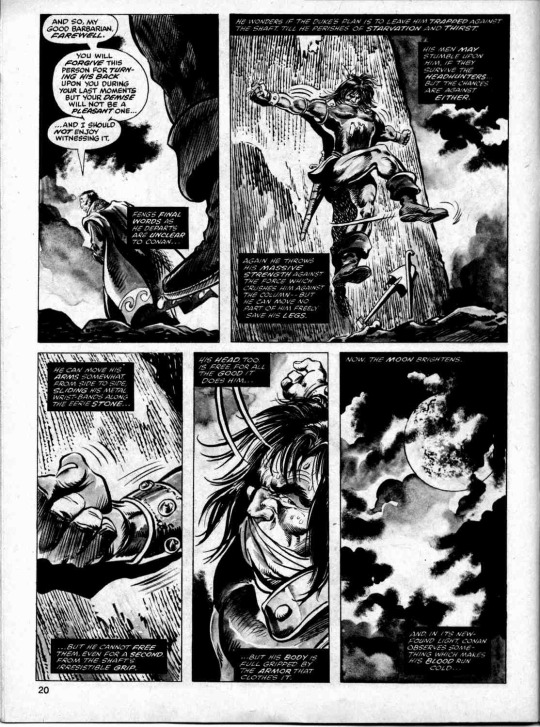

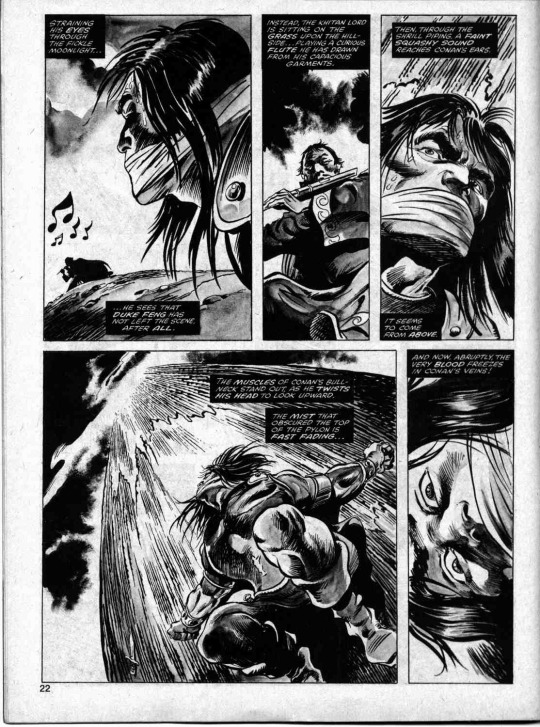




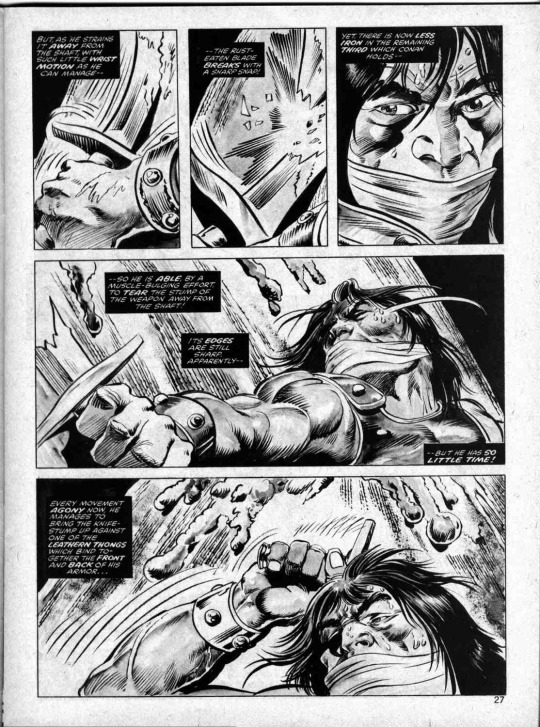

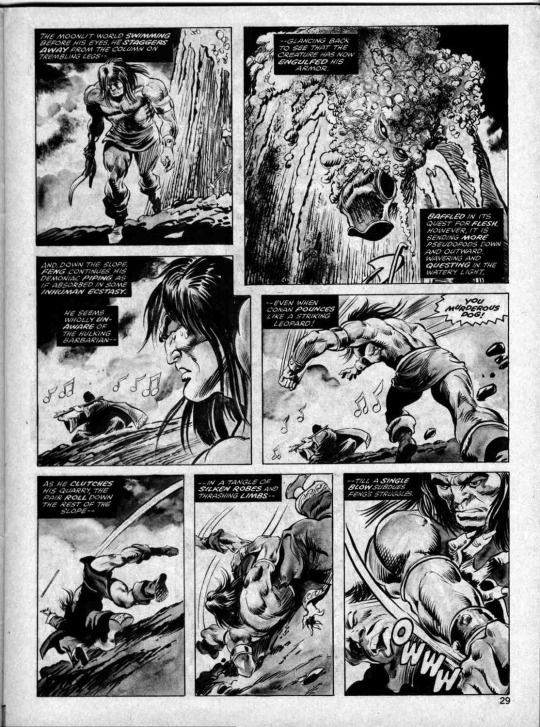
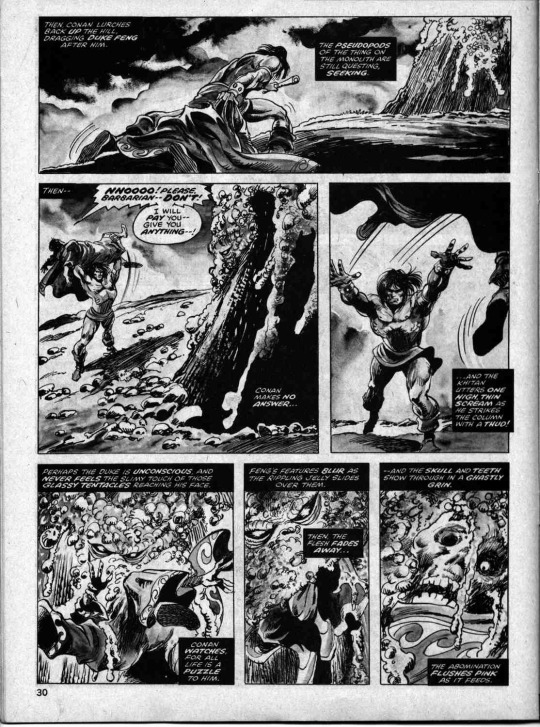
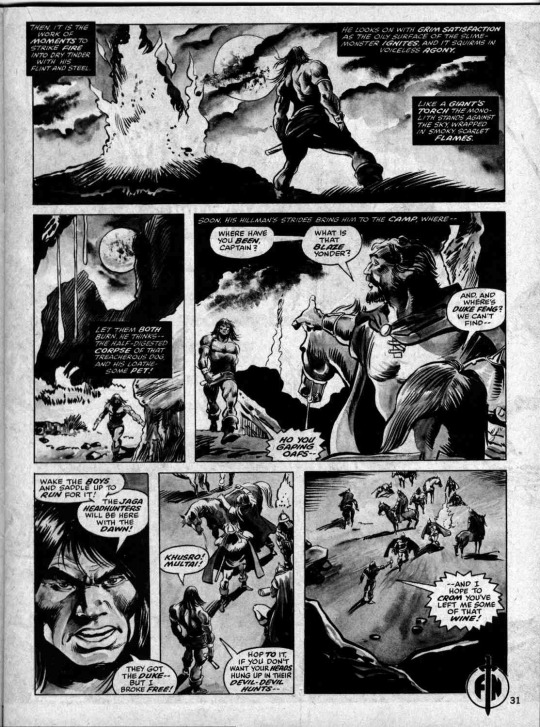
The Savage Sword of Conan the Barbarian #33 -September 1978-
"The Curse of the Monolith"
adapted from the story by L. Sprague deCamp and Lin Carter
script: Roy Thomas
art: Gene Colan and Pablo Marcos
#the savage sword of conan the barbarian#conan#the curse of the monolith#l. sprague de camp#lin carter#robert e. howard#roy thomas#pablo marcos#gene colan#comics
8 notes
·
View notes
Text
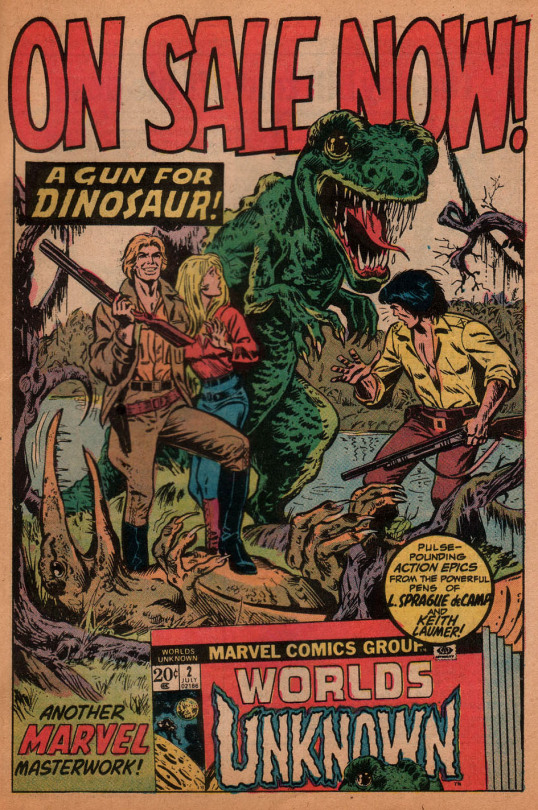
1973 ad for Worlds Unknown No. 2 from Marvel. Adaptations of A Gun for Dinosaur! by L. Sprague deCamp and Doorstep by Keith Laumer. This promo image, by Alan Weiss and John Romita, was also used as the cover.
11 notes
·
View notes
Text

THE WHEELS OF IF, And Other Science Fiction by L. Sprague DeCamp. (Chicago: Shasta, 1940) Dust jacket illustration by Hannes Bok. Short story collection contains:
"The Merman" (Astounding Science Fiction, February 1938)
"Hyperpilosity" (ASF, April 1938)
"The Gnarly Man" (ASF, June 1939)
"The Best-Laid Scheme" (ASF, February 1940)
"The Warrior Race" (ASF, October 1940)
The Wheels of If" (Unknown, October 1940)
"The Contraband Cow"
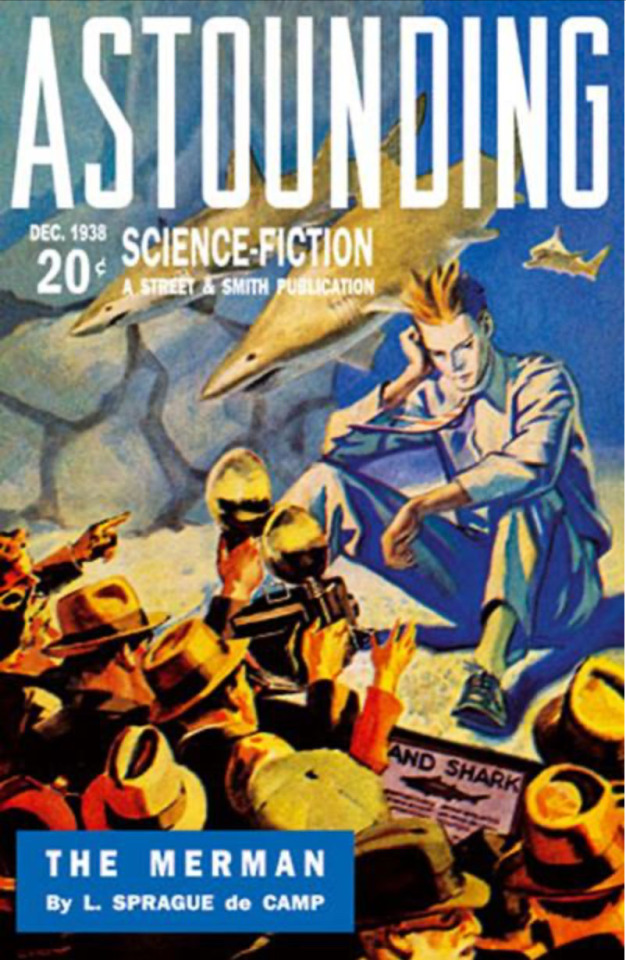
Astounding, December 1938 [v22 #4] Edited by John W. Campbell. Cover art by Charles Schneeman.
A Matter of Form by H. L. Gold [Gilroy]
“The Ephemerae” by Edmond Hamilton
Nuisance Value by Manly Wade Wellman [Part 1 of 2]
“The Merman” by L. Sprague de Camp
Simultaneous Worlds by Nat Schachner [Part 2 of 2]
“Helen O’Loy” by Lester del Rey
“Let Cymbals Ring!” by Moses Schere
“They Had Rhythm!” by Kent Casey [Private Kelton]
#book blog#books#books books books#book cover#pulp art#science fantasy#pulp fantasy#beautiful books#l sprague de camp#hannes bok#shasta#parallel universe#time travel#humor#john w campbell#astounding science fiction#charles schneeman#unknown#pulp cover
9 notes
·
View notes
Text
Back in the 1950 s L. Sprague deCamp wrote some stories in which the future world space powers were Portugal and India, as I recall. what I find amazing today is how many countries actually have their own space programs.
Random question for the Tumblerian hive mind. I'm working this weekend on a slightly silly but very fun writing project about the multinational crew of a near-future space exploration mission. I've decided that I want the mission commander to come from a country that isn't one of the current spacefaring "powers". What country should I choose? Bonus points if it's one I wouldn't necessarily be knowledgeable about, so I can have an excuse to do some serious research.
(I know I could just ask some LLM to spit out a list of random countries, but it's far more pleasant to talk to people.)
41 notes
·
View notes
Photo

An incisively aware and responsive warrior from the Black Kingdoms. Dark eyes, shone burnt sienna and shaded to highly polished gaboon ebony with obsidian cores, braziers for embers of passion residing within. Neither wide or closely set. A tall dark man, heavily tanned by the Saharan sun endowed with a massive thickly muscled physique tempered by leanness and definition giving lithe agility to the wide powerful frame.
Tsukumbe the Suba is an adaptive man dressing and grooming meticulously for the environment and situation at hand. Armed with spears & Nguni shield, a Mangbetu knife on his waist clad in loincloth, kilt, a girdle to protect internal organs and leopard headdress. A Pragmatic, utilitarian, minimalist and mobile like a desert nomad. Tsukumbe aspires for trade of true honest value than advantage or overpaying. Proud, vibrant and strong cultural value of prestige, prized possessions and trophies with a fondness of sport, hunting, agriculture, animal husbandry, iron and copper metalwork of a Bushman.
Stalwart, evenhanded, reserved, learned to speak/read the languages of the trade routes as well as navigate throughout the Black Kingdoms and outspoken to subvert expectation, preconceived notions and misdeeds of other Black tribal warriors. Tsukumbe strives for the feats of his actions to gain reputation and status exceeding the possession of gold and political marriage aristocracies as traditional key means to attain fame.
Ultimately, Tsukumbe will earn the seat of a throne in in the unstable Black Kingdom megacity of Tombalku with Conan the Barbarian as his general. Tensions in the city boiling over, and a bloody civil war ensue. Conan and his allies win, their enemies either killed or sent into exile in the desert, and he takes the throne beside Tsukumbe. However, a priest accuses Almaric of Aquilonia of killing their god and demands he and Lissa be tortured to death. Conan refuses and chaos erupts. Tsukumbe falls to betrayal by voodoo magic. Conan, Almaric, and Lissa manage to escape as the exiled tribes attack the city, and Tombalku collapses into fire and blood.
#traditional art#traditional fanart#Robert E. Howard#l sprague decamp#lin carter#bushman#tribal warrior#african warrior#muscular man#bodybuilder#sweating#rhinoceros#pygmy#warpaint
2 notes
·
View notes
Text
Mez-Conan: Iconic Frazetta Image Gets Mezco Toyz' One:12 Collective Homage
Mez-Conan: Iconic Frazetta Image Gets Mezco Toyz’ One:12 Collective Homage
Frank Frazetta’s iconic “Conan the Adventurer” cover gets Mezco’s One:12 Collective treatment. (image courtesy of Mezco)
1960’s fantasy fandom hung heavily on author Robert E Howard’s 1930’s novels reissued in paperback form. Their affordability and portability put them in the hands of young readers who, though likely unaware of their prior lineage in pulp magazines like Weird Tales, loved them…
View On WordPress
#action figures#articulated dolls#conan#conan the adventurer#diabolik#frank frazetta#frazetta girls#ghostbusters#gomez#l sprague decamp#lancer books#mezco#mezco toyz#one:12 collective#paperbacks#popeye#pulps#robert e howard#superheros#sword and sorcery#toy fair#weird tales
1 note
·
View note
Text
If We Do Not Know Our History (of Dumbass from Our World Ends Up Somewhere Else) We Are Doomed
to say something stupid like, "...before isekai got popular in the West."
Just. I am laughing. This particular genre is/was wildly popular, and only briefly went out of fashion because it was "tired" and "cliche" according to critics.
More or less from the top of my head:
Night-threads, by Ru Emerson This is a series from the 1990s. Three people from Cali end up in fantasy setting
Sword and the Chain, by Joel Rosenberg this is a series from the 1980s Our Heroes are college students who a brought into a another world by a wizard (who lured them in via a table top rpg campaign that basically detailed the world they'd get dumped in.) When confronted by the reality of the slave holding societya they didn't have any problem with as a fantasy setting, they go a little feral.
Thomas Covenant the Unbeliever Stephen R. Donaldson: titular character ends up in fantasy world and spends a great deal of the time refusing to believe he's in fantasy land. First series ran in the seventies, second series in the nineties, third around 2013.
The Seventh Sword by Dave Duncan: This is another one where the character doesn't believe he's been brought into a fantasy land. At least he's easier to convince. This series is from the 1990s. Not a favorite! I think of this as being the spiritual opposite of The Sword and the Chain
Doomfarers of Coramond by Brian Daley: In which an armored personel carrier full of soldiers find themselves transported from Vietnam to a fantasy world. this book and it's sequel is from the seventies.
Witchworld novels by Andre Norton several of the books in this series involve people from Earth ending up in the Witchworld. This series is from the 1960s all the way to early 2000s, several books published after the writer's death, and many other writers brought into the project.
Tredana Cycle, by Joyce Ballou Gregorian, comprising "The Broken Citadel," "Castledown," and "The Great Wheel." Our Heroine is a girl (and later young woman) who keeps getting drawn into another world called "Tredana." The first time, when she's twelve, the next in her twenties, and the final time in her thirties. This series is from the seventies.
Mirror of Her Dreams by Stephen R. Donaldson Clinically depressed young woman ends up in a fantasy world. things go poorly for her, since the magic involves mirrors and for a change, the fantasy people don't think the person from the other world is real. (Not a great situation for a mentally ill young woman to be in.) If I recall, this one is from the eighties or nineties
Darwath Trilogy by Barbara Hambly Wizard recruits people from our world to help with entities known as "The Dark" which prey upon humans. This series is from the 1980s. I don't remember many details.
Windrose Chronicles by Barbara Hambly Our Heroine and another dude end up in fantasy world. Bad Horrible things happen, the details of which I'm fuzzy on. This series is also from the 1980s.
Spellsinger, by Alan Dean Foster, another series from the 80s! Our Hero is a college student brought to a fantasy world full of humans and anthropomorphic animals! His innate magical ability is needed to help fight the evil insect empire. Stuff happens.
A Wizard in Rhyme by Christopher Stasheff Our hero ends up in a universe where poetry makes magic and the major conflict is between Good Christians and Evil Mages who literally work for the devil. This series is mostly from the eighties and 90s and while entertaining, also causes me to twitch in irritation.
Lest Darkness Fall L. Sprague DeCamp A historian ends up in the past, and uses Historian Powers (no I'm not exaggerating) to change history.
The Amber Chronicles by Roger Zelazny I feel these books also count as isekai, though our protagonist is from fantasy world who travels to other worlds. (technically, his fantasy world is the only real world and the other worlds are shadows.) There was a series in the seventies, and a second series in I think the eighties/nineties. I prefer the "Merlin" set to the earlier "Corwin" set.
The Changeling/Madwand by Roger Zelazny from the 1980s. Our Hero was from fantasy land, from where he was sent as a baby. Meanwhile the kid he was replaced with is in fantasy land trying to start an industrial revolution, eternally frustrated by fantasy land's reliance on magic.
Dragonsword Trilogy by Gael Baudino This fantasy trilogy is basically a screed against Gor. This trilogy IIRC is from the 90s.
Dragon and the George Gordon R. Dickson Our Hero is not only in fantasy land, he is now a Dragon. I have never actually read this book.
Edgar Rice Burroughs Barsoom books are an isekai, though more or less science fiction based. These were written in the 1930s. I have read many of the books in this series.
A Voyage to Arcturus by David Lindsay, from the 1920s. another more or less science fiction based isekai. I have only skimmed this one.
Do I need to mention the Chronicles of Narnia? by C.S. Lewis? Or his Space Trilogy?
There are others: this is by no mean an exhaustive list, just the ones that came immediately to mind. "Isekai" is a pretty standard concept in western science fiction and fantasy and by no means something that *isn't* popular?
21 notes
·
View notes
Text
Below is a photo of the cover of the first major publication of a Lovecraft biography. This hardcover version came out in 1975. Though August Derleth had been planning to write a bio of Lovecraft he unfortunately died in 1971 before it could be completed. There was a tremendous upsurge in interest in Lovecraft's work almost imeadiateIy after Derleth's death. Versions of COOL AIR and PICKMAN'S MODEL were filmed for Rod Serling's TV program, NIGHT GALLERY. Additionally Skull Comics published 2 editions of illustrated comics dedicated to Lovecraft's works. A series of paperbacks with eye-catching cover-art by John Holmes sold in unprecedented numbers and THE FIRST WORLD FANTASY AWARDS convention opened in Providence, RI in Oct. 1975 and that extremely well run and successful event was dedicated to H. P. Lovecraft primarily. L. Sprague deCamp's biography was also available that same year. Unfortunately deCamp was not the right person for the task as it turned out. His biography of Lovecraft was almost universally panned by the growing underground Lovecraft community. If deCamp thought his bio would be seen as anything other than a malicious attack he was severely mistaken. Anyone who might have hoped or expected that a fellow writer of imaginative fiction like deCamp would have some sympathy for his subject was sadly in error. Lovecraft was presented to the public at large as a childish, spoiled, effeminate, loser, a delusional bigot, a pathetic excuse for a husband and provider, a rabid racist, a Nazi sympathizer, a mamma's boy, a poor excuse of a writer in general, an utterly impractical human being, and in the end his own worst enemy. If deCamp reckoned that there was a paying audience for this drivel he was wrong. The First World Fantasy Awards convention was a considerable success but deCamp's book was not welcomed there. Anyone other than a fan of horror fiction who might have chanced to read this piece of garbage came away with nothing but EXTREME ill feelings for Lovecraft. deCamp MAY have seen writing the Lovecraft bio as a chance to cash in on Lovecraft's rising fame. If anything 'LOVECRAFT A Biography' destroyed any possibility of a wider audience for HPL. Though deCamp may not have intended his study to be so, the book ended up essentially as a "Hit Piece" and the negative effect of the thing still resonates till this very day. Others outside the core fans used Lovecraft's worst attributes to bolster their anti - Anglo political agenda's. Amongst the casual public who know H. P. Lovecraft first and formost as an rabid racist I believe L. Sprague deCamp was the one who first pushed the snowball rolling. DeCamp may have ended his bio with a few sympathetic observations on HPL, but these came late in the project and hardly meant anything to those who might have waded through the brutal attack that filled the book beforehand What could have been? (Exhibit 563)
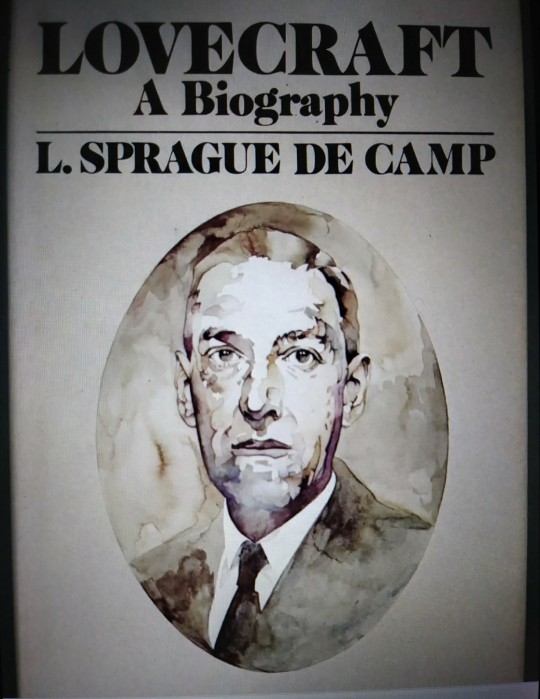
6 notes
·
View notes
Photo

🔸I've enjoyed CONAN as depicted by only FIVE creators. Of course without ROBERT E. HOWARD there would be no Conan. FRANK FRAZETTA's cover paintings were deviating and savage. I'm even throwing in L. SPRAGUE DeCAMP as well, as he expanded on the universe. And finally, JOHN BUSCEMA fully realized his adventures along with ROY THOMAS on a monthly basis. Anything outside of that has always made me go back to these four to compare. Even the gorgeous work of JORGE ZAFFINO. Maybe I'm just narrow-minded. #shanewhite #comics #illustration #concepts #art #traditional #digital #mixedmedia #conan #conanthebarbarian #frankfrazetta #johnbuscema #robertehoward #roythomas #lapraguedecamp https://www.instagram.com/p/B7iu2CfBCdn/?igshid=8cz7ki86qpqb
#shanewhite#comics#illustration#concepts#art#traditional#digital#mixedmedia#conan#conanthebarbarian#frankfrazetta#johnbuscema#robertehoward#roythomas#lapraguedecamp
1 note
·
View note
Photo
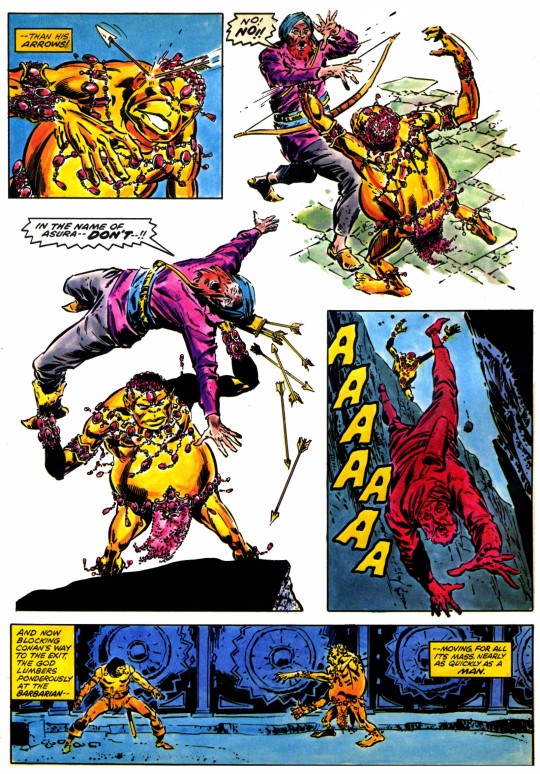
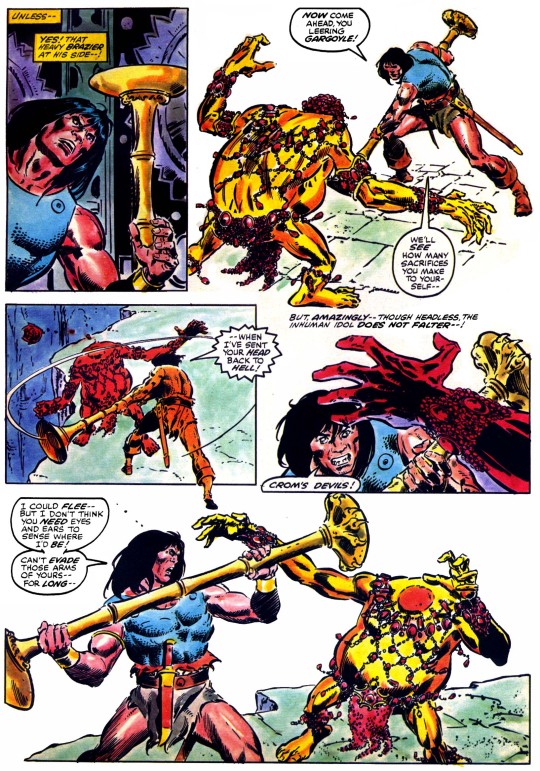
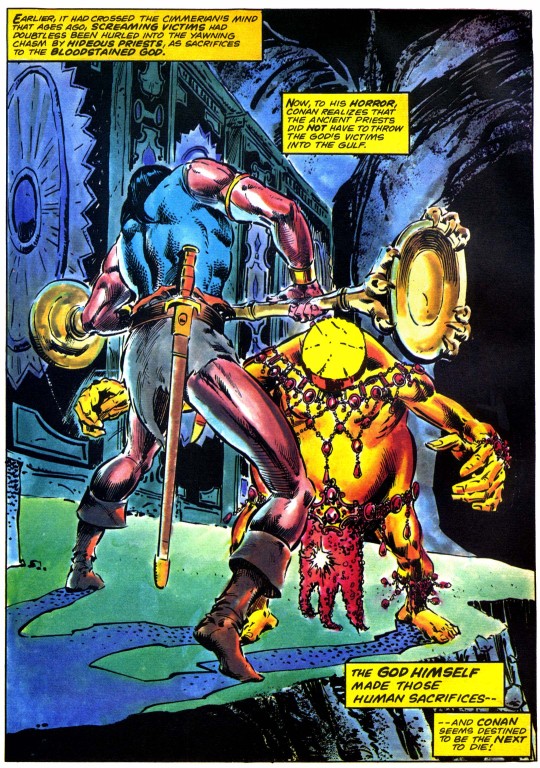
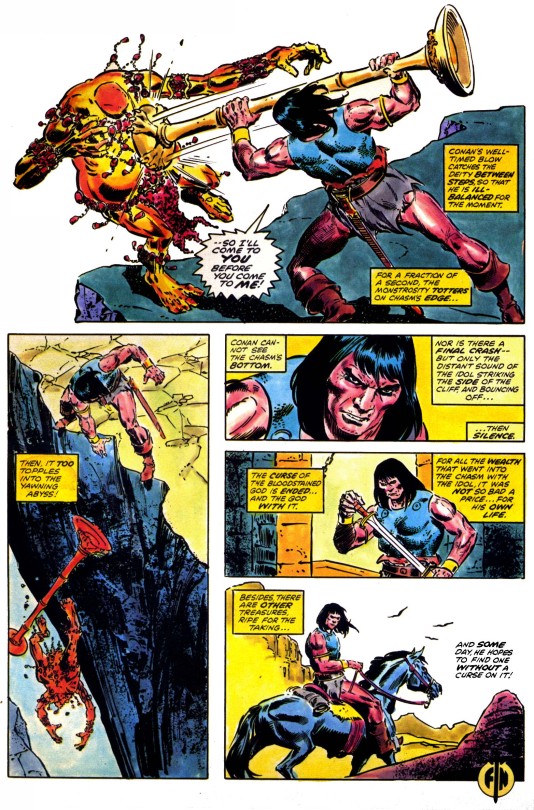
The Savage Sword of Conan Super Special 1976
“The Trail of the Bloodstained God” (31-34 of 34 )
script by Roy Thomas
art by John Buscema and Tony DeZuniga
based on the story by Robert E. Howard and L. Sprague deCamp
#the savage sword of conan#Conan#comics#the trail of the bloodstained god#Roy Thomas#John Buscema#Tony DeZuniga#Robert E. Howard#L. Sprague deCamp
12 notes
·
View notes
Photo
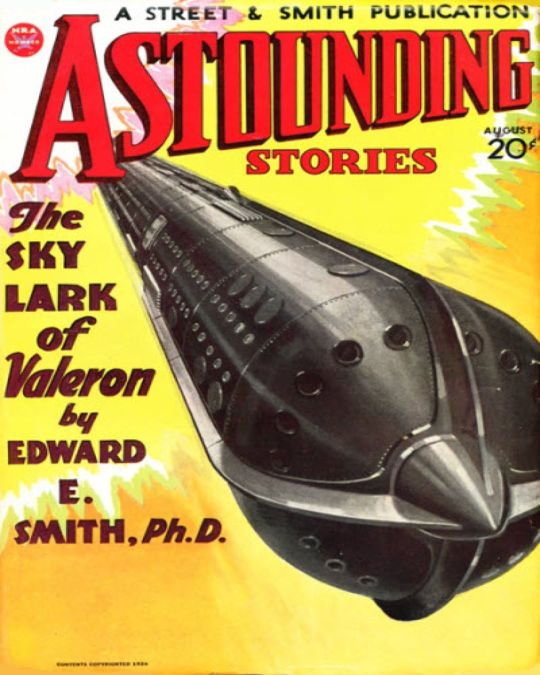
Aided by his editorial assistants, Desmond Hall and, later, John W. Campbell, F. Orlin Tremaine hoped to diminish the literary bias against science fiction by publishing unusual works by the best science-fiction writers of the 1930s. L. Sprague DeCamp, Raymond Z. Gallun, Murray Leinster, Frank Belknap Long, H. P. Lovecraft, C. L. Moore, Ross Rocklynne, Eric Frank Russell, Nat Schachner, E. E. Smith, Don A. Stuart (John Campbell’s pseudonym), John Taine, Donald Wandrei, Stanley G. Weinbaum, Jack Williamson, and others could be found in Tremaine's ASTOUNDING. Here’s one by E. E. Smith: “The Skylark of Valeron,” a seven part serial that began in the August 1934 ASTOUNDING STORIES, featuring cover art by Howard V. Brown. https://www.instagram.com/p/B9Aq2pgnawW/?igshid=e0uhwyawif8e
0 notes
Text
Sensor Sweep: Wulfhere, Monster Manual, Heroism, Howard A. Jones
Heroism (Rogue Blades Entertainment): “The heroic books, even if printed in the character of our mother tongue, will always be in a language dead to degenerate times …” Henry David Thoreau wrote those words in the mid-19th Century for his distinguished book, Walden. They rang true then and they ring true today. Of course there will be those who say we do not live in degenerate times, that we live in the greatest of all ages, that our technological and social achievements are pressing us towards some utopia, but those who are true students of history and have open eyes might argue otherwise, or at least they might hold more than a little skepticism about the potential greatness of the immediate future.
Fantasy (Tor.com): Here’s a funny thing about “action reads:” a lot of people would equate that to mean a whole lot of running and chasing and swordplay. They wouldn’t be wrong, of course, but all the physical action in the world can’t liven up a bland tale, or make boring characters interesting, and there’s actually plenty of forward momentum and tension to be had in some fantasy adventure stories without the more obvious blood-letting. And then of course there’s lyrical prose. Me, I prefer to see my action with great characters and some lovely writing, and today I’m going to share a few favorites that deliver all those things.
Writers (Slate.com): Three years ago, over breakfast, my friend Helen handed me a novel about a quest that, unknown to both of us, would set me off on a quest of my own. The book was called The Dragon Waiting, and it was written by the late science fiction and fantasy author John M. Ford. Helen placed the mass-market paperback with its garish cover in my hands, her eyes aglow with evangelical fervor, telling me I would love it. I would soon learn that, owing to Ford’s obscurity, his fans do things like this all the time. Soon, I would become one of them.
Writers (The Nerd Daily): In this sequel to For the Killing of Kings, Howard Andrew Jones returns to the ring-sworn champions of the Altenerai in Upon the Flight of the Queen to continue this thrilling, imaginative and immersive epic fantasy trilogy.
We had the pleasure of chatting to author Howard Andrew Jones about his upcoming fantasy sequel Upon the Flight of the Queen, which publishes on November 19th from St. Martin’s Press. Howard talks about what readers can expect and the challenges he faced, the inspiration behind the trilogy, what’s next for him, and more!
Genre Fiction (Dark Worlds Quarterly): There are those Fantasy writers and critics that accuse Robert E. Howard’s Conan of lacking any depth because he just hacks his way out of trouble. In fact, I think it was Robert Bloch in his intro to Wolfshead (Bantam Books, 1979) who said it, qualifying his words with the fact that he preferred Howard’s subtler characters such as Kull or Bran Mak Morn. I would hate to disagree with such a wonderful writer as Bob Bloch but I think he kinda missed the point. We want to see Conan hack his way out. Just as people pay gobs of money to be ringside at a boxing match.
Subculture (Amatopia): But if you show up humble and willing to learn, and don’t lie about knowing stuff about the subculture, you’ll find you have a whole bunch of cool new friends eager to help ease you in. At the very least, the people in the subculture will respect you, even if they may resent your intrusion. In time, you learn to be a part of the crew.
Fantasy (Matthew J. Constantine): The first novel in the Prydain Chronicles, The Book of Three introduces us to Taran the assistant pig-keeper, Hen Wen the pig, Gurgi the…um…wildman?, and the rest, as well as the Welsh inspired land of Prydain. The book drips with a sort of gauze filtered, dreamy Fantasy in a similar vein to Tolkien’s Shire, particularly from The Hobbit. Reading the book, I kept thinking it would have fit as a comic strip in the tradition of Prince Valiant. It also has a lot that could translate well into an animated film or potentially a live action film these days.
D&D (Skulls in the Stars): Die, Vecna, Die! (2000), by Bruce R. Cordell and Steve Miller. This module has the curious distinction of being perhaps the last “old school” adventure ever published! Die, Vecna, Die! was one of two mind-bogglingly epic adventures released with universe-spanning ramifications, allowing DMs to have a reason for transitioning from 2nd edition AD&D to Wizards of the Coast 3rd edition D&D. The other is The Apocalypse Stone (2000).
Fiction (DMR Books): Next week DMR Books will make our first foray into historical adventure fiction with the first book publication of Wulfhere by A.B. Higginson! Wulfhere, Higginson’s only novel, was originally serialized in Adventure magazine in 1920. In the Dark Ages of England, kingdoms were ready to be carved out by any with the ambition and might to do so. The mightiest ruler of all was Penda, Lord of Mercia, a man as strong as he was ruthless. He had no equal in martial prowess, except for his son Wulfhere…
Tolkien (Alas Not Me): Crucial to the tale of Eärendil the Mariner is his ship, Vingelot or Vingelótë, without which Eärendil would have been stuck in a port on a western bay where lonely sailors pass the time away talking about their homes. The name Vingelot gives us a tantalizing and frustrating example of how very easily stories can be lost, likely forever.
Writers (Mystery File): Over the course of his writing career, Clark Howard may have written over 200 short stories, not all of them criminous in nature, plus a couple dozen crime novels and collections. This does not include an unspecified number of works of true crime the editor of EQMM mentions in her introduction to this tale. Howard hardly ever used a character more than once, and “Blues in the Kabul Night” is no exception. When mercenary for hire Morgan Tenny smuggles himself into war-ravaged Kabul, the capital of Afghanistan, it is for a specific reason. His twin brother is in a high security prison there and scheduled for execution soon, unless Morgan can do something about it.
RPG (Brain Leakage): As I mentioned a few weeks back, I’ve been at work on an Appendix N inspired science fantasy series, one that envisions what D&D fiction might have looked like if it followed the wilder literary roots of the game, rather than filling in the map of TSR and WotC’s pre-fab fantasy worlds. And while I still plan on writing that, the fact is my recent thought experiments on what Fantasy Effing Vietnam would look like have gotten a bit more attention. To the point that I’ve gotten several messages in public and in private expressing interest in a published print version.
Calendars (Mens’s Pulp Mags): Now, with Eva’s permission, we’re offering a special collectible to go with the book: the Authorized 2020 Eva Lynd Calendar. It’s a limited edition calendar featuring photographs and artwork Eva modeled for, and it’s available exclusively from me on eBay. If you’re a regular reader of this blog, you probably know why Eva Lynd is so familiar to fans of the men’s adventure magazines (MAMs) published in the 1950s and 1960s.
Fiction (Sacnoth’s Scriptorium): So, I’ve been trying for a long time to find an answer to the two questions: Did the Inklings ever read Lovecraft? And Did Lovecraft ever read the Inklings? So far as the first question goes, the answer is: still not proven. We know that Warnie Lewis was a fan of ‘scientifiction and read some of the pulp magazines like AMAZING STORIES. And THE NOTION CLUB PAPERS suggests that the Inklings were fairly conversant in science fiction. Certainly there are some echoes of Lovecraftian themes in Tolkien’s account of the Things beneath Moria, Lewis’s description of the subterranean world far beneath the surface of Venus, and especially Wms’ Cthulhesque octopoid-lords of P’o-l’u.
RPG (Walker’s Retreat): With last weekend’s Big Brand marketing event masquerading as a fan convention came the announcement–with no release date–of the fourth installment of its iconic isometric dark fantasy action RPG franchise. You know which one I’m talking about, and it’s not the MMORPG. I thought I’d take the time to give you all some alternatives that you may have overlooked or forgotten about, beside Path of Exile and adaptation of other Big Brand properties.
Art (Pulp International): Above, numerous Italian posters for 1960s and 1970s westerns. Some of these movies were true spaghetti westerns (produced in Italy and shot in Europe, often Spain), while others are U.S. productions. All the imagery is beautiful. The artists responsible include Renato Casaro, Rodolfo Gasparri, Averardo Ciriello, Aller, aka Carlo Alessandrini, et al.
Review (Hillbilly Highways): I bought Congregations of the Dead over a year ago on a bit of a lark because it was cheap. Which isn’t to sale that it didn’t sound right up my alley. A country noir/urban fantasy/horror mashup with significant pulp influences? (A secondary character is named Carter DeCamp in an obvious homage to Lin Carter and L. Sprague de Camp and Manly Wade Wellman’s characters Silver John and John Thunstone seem obvious influences as well.) What I didn’t realize is how damn good it would be.
D&D (The Other Side): For today’s Monstrous Monday I want to do another review. For this one, it still follows my ‘Back to Basic’ theme I have been doing all year even though it is not a Basic-era D&D book. It is though one of my Basic era books. The book is the Monster Manual and it was just about 40 years ago that I first held this book in my hand. This is the book. This is the book that got me into D&D and RPGs.
Warhammer (Warpscream): This book opens with a look at the bleak life of the average imperial citizen. Urinating in water recyclers on the arid world of Baal. It’s one of Guy Haley’s strengths is that he can paint such a despondent picture so rapidly to open with. The story briskly moves along as we are made aware of a dire threat to the world of the Blood Angels.
Writing (Frontier Partisans): I guess it triggered a memory of Robert E. Howard’s description of his own trip to the Carlsbad Caverns in the early 1930s. Howard is best known for his creation of the fantasy character Conan of Cimmeria — and he translated his experience in New Mexico directly into a Conan story. . . The power of the works of J.R.R. Tolkien derives in great part from his ability to evoke a landscape that is at once fantastical and real. Tolkien was profoundly affected by landscape — beloved and comfortable; awe-inspiring; terrifying and appalling.
Sensor Sweep: Wulfhere, Monster Manual, Heroism, Howard A. Jones published first on https://sixchexus.weebly.com/
0 notes
Text
Fiona Mcvie Interviews Richard Lowe Jr
Hello and welcome to my blog, Author Interviews. My name is Fiona Mcvie
Let’s get you introduced to everyone, shall we? Tell us your name. What is your age?
My name is Richard Lowe, Jr. and I am 58 years old.
Where are you from?
I was born in northern California, lived most of my life in Southern California, and in 2013 moved to Florida.
FA little about yourself (ie, your education, family life, etc.)
I was an Air Force brat, born in a small community in northern California, near where my father was stationed. My mother often spoke of the good times she had at the Nut Tree restaurant, eating dates and drinking soda pop. Eventually, the family found its way down to San Bernardino, a dusty city at the base of the San Bernardino Mountains in California. My dad left the Air Force and became a graphics artist civil servant working out of Norton Air Force Base.
I have quite a few great memories of childhood in that dry, hot and dusty city. I sheltered from the heat in a tree house that my dad and I built together. Everything changed on the fateful day in 1967, when I was dragged into a library kicking and screaming by my mother. She had determined that I needed to experience a library – that it was time for me to become a reader. The screaming stopped as soon as a librarian gave me a cookie and took me on a tour of the whole building. I fell in love with the librarian and with books, and before long I checked out as many as a dozen a week. As I grew older, I read every book that I could get hold of.
In junior high school, I ran across a book carefully stored in a box that my grandmother had left with the family for safekeeping. That book was called Stranger in a Strange Land by an author name Robert Heinlein. I read that masterpiece in a weekend, and soon discovered other authors such as Isaac Asimov, Jack Vance, and John Campbell. After pouring through those books, I decided I was going to be an author when I grew up.
Life got in the way of my dreams, as sometimes happens. The family moved to Lake Arrowhead and my parents open an art gallery in Blue Jay village. A few years later, they opened a larger store in Lake Arrowhead Village and sold arts and crafts.
For me, the pressure of high school college, a full-time job, and eventually marriage and family got in the way of my dream of becoming a writer.
In 2005, my wife passed away and I decided that grief was something that I wanted to get out of his quickly as possible. I became a photographer and photographed every national park in the western United States. From there, I was introduced to some dancers, and became a very well-known performance photographer in Southern California. During those eight years, I photographed over a thousand women, did 1200 performance shoots, and photographed over 300 Renaissance festivals, Civil War re-enactments, and other similar events.
For 33 years, I worked in the technology field, first as a vice president of a computer consulting company, then as a senior designer, and finally settled down to a job at Trader Joe’s as their computer operations director. I worked at Trader Joe’s for 20 years, managing a team of eight people and varying numbers of consultants to keep their operations working well.
In 2013, I decided it was time for me to finally pursue my dream of becoming a writer. I left my job at Trader Joe’s, moved to Florida, and settled down to become a freelance writer, ghostwriter, and author. Since then, I’ve written and published 63 books of my own in my name, a number of others under pseudonyms, ghost-written 22 books, and written several hundred articles for blogs and publications. I’ve also written over 300 LinkedIn profiles for business leaders, ambassadors, government officials and others.
Tell us your latest news
I’ve created a new series of courses called Fiction Master Class which are designed to help writers improve their abilities and careers.
For the past few months, I’ve been interviewing 1 to 2 authors per week as part of a podcast designed to showcase their talents and abilities.
And I just finished writing my 22ndghostwritten book.
When and why did you begin writing?
I’ve written most of my life, generally for work related projects such as technical manuals, articles for technical magazines, and so forth. In 2013, it was time to change direction, and writing seem to be the natural place to put my talents.
When did you first consider yourself a writer?
I first considered myself a writer when I published my first best-selling book, Focus on LinkedIn. I sold over 10,000 copies and became an Amazon Kindle bestseller, in the top 100 for several days. That was my third book.
What inspired you to write your first book?
My first book was a labour of love. I always been interested in computer security, and I decided to take my knowledge and help others understand how to make the computer secure. The book didn’t sell well, but that didn’t matter. I just wanted to write all of that down in a very well done book.
Right now, I’m working on a novel called Peacekeeper, which is based about a million years in the future. This will be my first science fiction novel, and I expected to be between 80,000 and 100,000 words long. I’ll focus the rest of the answers about my book on this one.
How did you come up with the title?
Peacekeeper is the name of a type of fleet of spaceships designed to keep the peace, hence the name of the book.
Do you have a specific writing style? Is there anything about your style or genre that you find particularly challenging?
I tend to write in a casual or business casual format.
I can work in any genre, from romance to science fiction to mystery to nonfiction. I haven’t found anything yet that I can’t write.
How much of the book is realistic and are experiences based on someone you know, or events in your own life?
Absolutely none of this book is realistic or based on experiences of anyone I know.
To craft your works, do you have to travel? Before or during the process?
No.
Who designed the covers?
Haven’t designed the covers yet.
Is there a message in your novel that you want readers to grasp?
Yes, the book is about how big governments can be ruthless and enslave people, and how eventually the people revolt against their masters, regardless of the cost.
Who is your favorite writer, and what is it about their work that really strikes you?
My favorite writers are J.R.R. Tolkien, Mike Resnick, Robert Heinlein, Jack Vance, Winston Churchill, L Sprague DeCamp, Arthur Hailey, Alan Dean Foster, Robert Aspirin, and Fred Saberhagen.
What strikes me about their works is they are all well plotted, faithful to their genre, have strong characterization, and the stories tend to be solid.
Outside of family members, name one entity that supported your commitment to become a published author.
The Alliance of Independent Authors
Do you see writing as a career?
Writing is my career for the rest of my life.
If you had to do it all over again, would you change anything in your latest book?
Nope.
Did you learn anything during the writing of your recent book?
I learned that writing is easy for me. I can literally right between 10,000 and 12,000 words every day.
If your book was made into a film, who would you like to play the lead?
For the Peacekeeper book, the admiral would be played by Milla Jovovich.
Any advice for other writers?
If you’re writer you have to write and get published. So don’t make any excuses, don’t stop, don’t accept any failures, just right.
Anything specific you want to tell your readers?
Hope you enjoy my books, and please let me know what you think of them.
What book are you reading now?
I’m working on a book called Peacekeeper, which I mentioned earlier.
Do you remember the first book you read?
I remember the first adult level book I read was Stranger in a Strange Land. One of the early books I read was also Narrow Land by Jack Vance
What makes you laugh/cry?
I laugh every day, because life is supposed to be fun.
Is there one person, past or present, you would love to meet? Why?
I think I’d like to meet Isaac Asimov. He is one of the most prolific authors ever, and he had a way of making difficult understand subjects simple to comprehend. He is one of the reasons why I decided to become a writer.
Do you have any hobbies?
I’ve got several hobbies. First of all, I’m a photographer, I collect amethyst and quartz crystals, miniature fantasy figurines, stamps, movies, and books. These days, my life mostly centers around writing since that’s my passion.
What TV shows/films do you enjoy watching?
My favorite movies are the Lord of the Rings trilogy and Godfather 1 & 2. To me, these are among the most well-done movies of all time.
I’m enjoying watching The Expanse, and can’t wait for season four.
Imagine a future where you no longer write. What would you do?
I’d probably be a photographer, because I’m a creative person and that’s just a different kind of creativity.
You only have 24 hours to live how would you spend that time?
I have no idea.
What do you want written on your head stone?
I don’t want a headstone.
Do you have a blog or website readers can visit for updates, events and special offers?
https://www.thewritingking.com/
https://www.fictionmasterclass.com/
All my books are at https://www.coolauthor.com
(Originally published in Author Interviews)
Author information
Richard Lowe Jr
Owner and Senior Writing at The Writing King
Richard is the Owner and Senior Writer for The Writing King, a bestselling author, and ghostwriter. He's written and published 63 books, ghostwritten 20+ books, as well as hundreds of blog articles.
| Twitter | Facebook | Google+ | Pinterest |
from WordPress https://ift.tt/2CYvfrl via IFTTT
0 notes
Text
Retro Fandom Friday – Astounding Sure Is Something…
After a great story by Arthur C. Clarke, I was all ready for the September 49 issue of Astounding to start getting good… Only to find that was the last story.
Okay, that’s not really fair, because maybe L. Sprague DeCamp’s The Queen of Zamba was fantastic, but it was the 4th and final installment of a serialized novel, which took up a good chunk of the issue.
Other features of the issue included a rather dry article on Cybernetics by E.L. Locke and something called “Progress Report”, by John H. Pomeroy, which was a lengthy jargon and BS-filled fake scientific report expanding on Astounding’s (particularly Asimov’s) prolonged trolling about Thiotimoline. I’m in no place to comment on this most literal approach to science fiction, so I’ll suffice to say that after a page or two I just skipped the rest.
The reviews of upcoming and current releases were so dry that even the books they praised sounded dull. Consider, though, the frame the reviewer is writing from that he needs to open with “Critics of science fiction insist that it can have no place as literature because it ignores basic human values; because its characters exist only to carry out some ingenious plot twist or put some novel gadget through its paces. However just this complaint may be when applied to the field as a whole, it is flatly refuted in the twelves stories by Lester del Rey which Prime Press has published under the title “…And Some Were Human”.” The guy writing reviews for Astounding Science Fiction ACTUALLY BELIEVES that the Big Men With Screwdrivers complaint is “just” when looking at “the field [of SFF] as a whole”? What a maroon!
While the letters section of the 1932 issue I reviewed was pure as the driven snow to the point where I ended up skipping doing a RFR on it (many letters were to the effect of “I’m Bob, and I love science! Here is my address so we may cordially correspond on subjects of scientific inquiry”), there was a bit more meat to write about in this issue.
Scandalous!
In a previous issue (Feb 1949), an Ursula Whitt had written in to claim her bona fides as a fan of science fiction, claiming to “have risked [her] reputation in college by defending science fiction in English class as belonging to great literature, and [she has] established a reputation among [her] friends as being an expert on rocket ships, time travel, and probability measurements.” This leads into her complaint that the Oct 48 issue had “left her speechless with ire and indignation” and had “offered nothing but the most mediocre stories, ideas, and entertainment in general.” She went on to complain as “the little average woman-on-the-street” that while “[she thinks] that men are lovely, [she doesn’t] think that they belong on the cover of a magazine dressed in nothing but B.V.D.’s.”
So in this issue, Eugenia Herman chimes in and states “[Ursula] is, of course, entitled to express any of her opinions, but when she says she does it “so that in the future you will know what ‘the little average woman-on-the-street’ wants out of her science fiction”, she generalizes from too few instances. Surely I’m as average as she is!”
Eugenia continues:
Personally, I read every word of your editorials, which have consistently struck me as intelligent, timely, and useful—thanks for the one on radiation and mutations, the only item I have seen anywhere on a subject surely interesting to many women—and I also read all the articles I can understand—about 40%–and never begrudge the space for those that others with more training than I can appreciate. Personally, I agree with Mrs. Whitt about the streamlined men on the covers, though they are infinitely preferable to the cutie-and-octopus covers on other magazines, and I like Bonestell covers the best. Personally, I violently dislike [Edd] Cartier’s illustrations, for to me his humans seem brutal and his nonhumans stereotyped, but I realize that I’m in a very small minority here, and I expect you’ll continue to use him and please other readers.
That’s enough to show that different women react differently! “
She goes on to mention that, among other things, she’s quite the fan of the Lensman series.
Ironically, of the three readers who wrote in with ranks for stories, all gave low marks for old Teddy the Sturgeon’s “Prodigy” (“”Devious Weapon” and “Prodigy” are a poor tie” [ranked 4th of 5]; “Sturgeon can do better than this”[ranked 5th of 5]; “I have no adverse criticism to make of this story, but have nothing good to say about it either” [ranked 4th of 6; included an article in the 5 slot]).
However, while George Price calls Chris Youd’s “Colonial” “An interesting new idea,” (4th of 5), Warren Carroll calls it “Very exasperating” [6th of 6]:
“There is enough Socialist propaganda being bandied about in these days without Astounding’s adding to the din. I, for one, am tired of these stories about grasping interplanetary capitalists and their murderous henchmen. And I am still mossbacked and reactionary enough to believe that a free press is and always will be one of the best safeguards for democratic freedom. Believing this, I have not the least sympathy for Mr. Youd’s obvious desire to kill off all reporters. Furthermore, despite all that is said in this story, I am not persuaded that Mr. Youd feels any real sympathy for the Venusians, for he leaves them still sunk the same rut at the end in which they were found at the beginning.”
Then he goes into the best segue I’ve ever read:
“The article on fluorine was good, although less so than I had expected.”
With Jay Zemel’s rankings for the April Issue, the #1 slot “Plague” being “one of the best in a long time” dropping to “Colonial” being “Neither bad nor good.” at number #2, I can see why the Astounding folks may have bought into Sturgeon’s Law. Maybe they weren’t reading good sci-fi?
We’ll see! I’ve decided to do an extended run of Astounding to get a feel for the magazine. Was this a bad issue? Or was Astounding a bad magazine that published just enough brilliant stories to fool people into thinking otherwise? Stay tuned in the coming weeks, where I’ll read Campbell-era Astounding so that you don’t have to!
Retro Fandom Friday – Astounding Sure Is Something… published first on https://medium.com/@ReloadedPCGames
0 notes